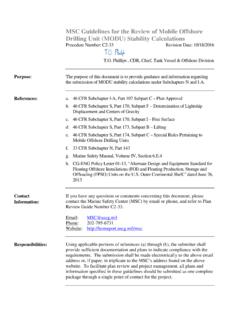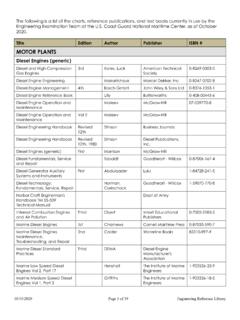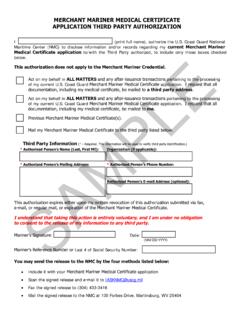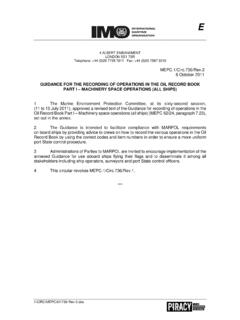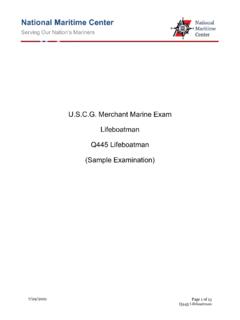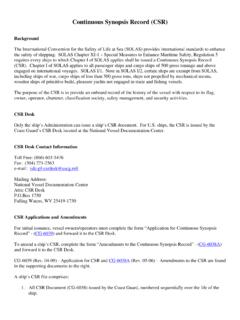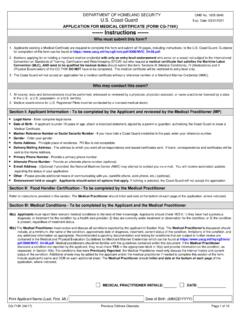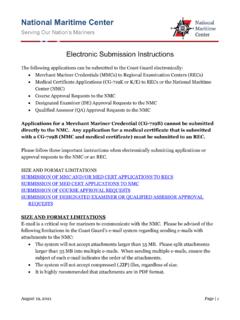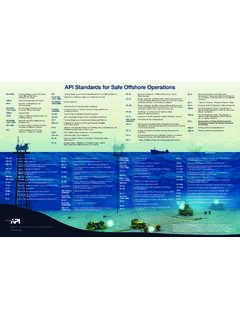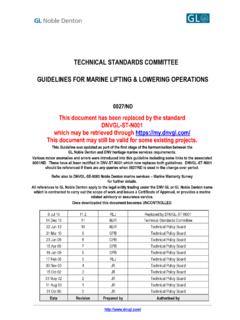Transcription of MSC Guidelines for the Review of OSV Stability
1 MSC Guidelines for the Review of OSV Stability Procedure Number: C1-06 Revision Date: February 13, 2013 R. J. LECHNER, CDR, Tank Vessel and offshore Division To establish a procedure for reviewing Stability calculations submitted for an offshore Supply Vessel (OSV) regulated under 46 CFR Subchapters I or L, operating on domestic and/or international voyages. a. 46 CFR 170, Subpart F, Determination of Lightweight Displacement and Centers of Gravity b. NVIC 17-91, Guidelines for Conducting Stability Tests c. ASTM F1321-92 (Reapproved 2008), Standard Guide for Conducting a Stability Test (Inclining and Lightweight Survey) to Determine the Light Ship Displacement and Centers of Gravity of a Vessel d. Marine Technical Note 04-95, Light Ship Change Determination e. 46 CFR 170, Subpart E, Weather Criteria f.
2 46 CFR 174, Subpart G, Special Rules Pertaining to offshore Supply Vessels g. International Convention for the Safety of Life at Sea, 1974, and its Protocol of 1988 (SOLAS), as amended. h. IMO Resolution (XII), Guidelines for the Design and Construction of offshore Supply Vessels i. Meyer, Richard and Feeney, Kevin. A Simplified Stability Letter for offshore Supply Vessels. Marine Technology, January 1981. The Society of Naval Architects and Marine Engineers. j. NVIC 3-89, Guidelines for the Presentation of Stability Information for Operating Personnel k. CG-ENG Policy Letter No. 03-12, Policy on the Implementation of IMO Resolution (16), Guidelines for the Transport and Handling of Limited Amounts of Hazardous and Noxious Liquid Substances in Bulk on offshore Support Vessels, for New and Existing offshore Supply Vessels, ,dated May 5, 2012 l.
3 IMO Resolution MSC. 235(82), including Adopted Amendments, IMO Resolution MSC. 335(90): Guidelines for the Design and Construction of offshore Supply Vessels, 2006 Purpose References MSC Guidelines for Review of OSV Stability Procedure Number: C1-06 Revision Date: February 13, 2014 Coast Guard Marine Safety Center 2 m. IMO Resolution (18): IMO Intact Stability Code n. IMO Resolution (85): 2008 Intact Stability Code (2008 IS Code) If you have any questions or comments concerning this document, please contact the Marine Safety Center (MSC) by email or phone. Please refer to the Procedure Number C1-06. Email: Phone: 703-872-6731 Website: Using applicable portions of references (a) through (n), the submitter shall provide sufficient documentation and plans to indicate compliance with the applicable requirements.
4 The submission shall be made electronically to the above email address or, if paper, in triplicate to the MSC s address found on the above website. To facilitate plan Review and project management, all plans and information specified in these Guidelines should be submitted as one complete package through a single point of contact for the project. If the vessel is new and not a sister vessel, has the Application for Inspection been submitted? In general no plan Review may occur until receipt of a copy of the Application has been received Is it clearly stated what is desired from the MSC? Are all plans requiring Coast Guard Review and/or approval submitted in triplicate? Are there any special or unusual requests involved? OSV Stability reviews generally fall into one of three categories, depending on the method the submitter uses to establish the acceptable range of loading conditions.
5 The greater this range, the greater the operational flexibility, and the greater complexity required in the Stability Review /guidance. The three most common methods are listed as follows, in order of increasing complexity: Stability letter with a limited number of specific authorized loading conditions. Simplified Stability letter with approved loading diagram(s). Approved T&S Book, with or without an accompanying Stability letter. Contact Information Responsibilities General Guidance MSC Guidelines for Review of OSV Stability Procedure Number: C1-06 Revision Date: February 13, 2014 Coast Guard Marine Safety Center 3 The simplified Stability letter with approved loading diagrams is the most common form of OSV Stability Review , as it provides a good balance of operational flexibility and simplified Stability guidance for the operator (see reference (i)).
6 Regardless of the type of Stability Review encountered, however, the basic requirement is that the submitter must clearly demonstrate that each possible loading condition meets the required Stability criteria of 46 CFR, Subchapter S. In order to establish a range of acceptable loading conditions, a common technique involves generation of a maximum KG or minimum GM curve. These curves typically plot the maximum KG or minimum GM value on the ordinate axis (y-axis), against the range of operational drafts on the abscissa (x-axis). Acceptable curves incorporate values derived from the most stringent governing Stability criteria, along with trim considerations. A satisfactory Stability Review results in operational guidance in the form of a Stability letter, and approved vessel loading conditions as indicated above.
7 If the T&S book includes sufficient operational restrictions, instructions, and guidance that would normally be included in a Stability letter (see reference (j)), then the MSC may return correspondence approving the T&S book in lieu of a Stability letter, noting that the operational instructions in the T&S book must be strictly followed. In addition, Stability reviews may be preliminary or final, depending on the basis of the lightship values. Preliminary Stability calculations are not required, but at the option of the owner/naval architect they may be submitted before the incline of the vessel, using assumed lightship values. This is often done to facilitate expedited final Stability reviews. Preliminary Stability reviews are conducted in the same manner as final Stability reviews, except that a Stability letter is not generated and all returned items are marked Examined.
8 Following the incline of the vessel and calculated results indicating the true lightship of the vessel, a final Stability Review may be accomplished and a Stability letter generated. A new set of Stability calculations is not required if the submitter demonstrates that the assumed lightship values closely match those resulting from the incline experiment (see reference (d) for further guidance and acceptable ranges). Verify the applicability of Regulations. See 46 CFR (Subchapter I), 46 CFR (Subchapter L), and SOLAS I/2, I/3, and II-1/1. Ensure the following items have been received (* as applicable): General Arrangements MSC Guidelines for Review of OSV Stability Procedure Number: C1-06 Revision Date: February 13, 2014 Coast Guard Marine Safety Center 4 Lightship values based on calculated results of Stability test data Lines, offsets, or computer disk with hull model (Recommended but not required) Hydrostatic Tables Tank Capacity Tables\Plan Ullage & Sounding Tables Maximum KG, or Minimum GM curves Intact calculations Damage Stability calculations* Lifting calculations* Towing calculations* Trim and Stability (T&S) Booklet, Loading Diagrams, or summary loading conditions* Verify lightship characteristics utilizing one of the following methods.
9 Does a sister vessel, with known characteristics, exist? Has an approved procedure and subsequent Stability test been performed in accordance with references (a), (b), and (c)? For each OSV on domestic voyages, the following Stability criteria apply for each condition of loading: Weather Stability criteria of 46 CFR 170, Subpart E Intact Stability criteria of either 46 CFR (b) or (c) {unusual proportion and form}, or {Rahola} the submitter may freely choose one of the two intact criteria but may not mix/match to suit depending on loading conditions or ranges in the vessels righting energy curve the full requirements of the chosen criteria must be consistently used throughout the entire set of Stability calculations if the unusual proportion and form criteria is chosen, the angle of maximum righting arm determines the specific requirements.
10 If above 30 degrees, (b) applies if less than or equal to 30 degrees, then (b) or (c) may be used if the Rahola criteria is used, the Stability letter must specify a maximum freeboard at the stern in accordance with Table If the OSV carries NLS cargo in Chapter 17 of IBC Code or any cargo that has flash point less than 60 deg Celsius (closed cup test), the OSV must meet the intact Stability requirements in reference (k). MSC Guidelines for Review of OSV Stability Procedure Number: C1-06 Revision Date: February 13, 2014 Coast Guard Marine Safety Center 5 Damaged Stability criteria of 46 CFR or 205, if the vessel is regulated under Subchapter L. Note the following: applies if 16 or fewer offshore workers are carried (damage is applied only along the sides of the vessel along the length of the engine room).
